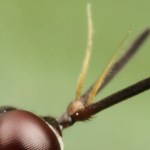Nature
The Neotropical Companion by John Kricher came out years ago, in the late 80s if I recall correctly. I've got a copy of it around somewhere.
I loved that book because it did a great job integrating all the things in one place: animals, plants, habitats, evolution, etc. Even though I was working in the paleotropics at the time, I found it informative.
Then, more recently, I got a revised version of the same book. I've got it around somewhere. It is from the 1990s, I think. Great book, same idea as the first one, but with more in it, and a somewhat larger format. This dates to after my…
Oh, no, Nature. Not you. Not again.
It wasn't enough that you were busted shilling for traditional Chinese medicine with a big, glossy advertising supplement a few years ago. I thought you had learned your lesson after that, as you didn't do it again. Maybe I was wrong. Granted, your offense this time is not quite as bad as accepting cash from Saishunkan Pharmaceutical Co., ltd. and the Kitasato University Oriental Medicine Research Center to put together what was in essence pure propaganda for quackery, but, on the other hand, I do have to be worried that you might be thinking of backsliding…
The ‘Nifty Fifty (times 4)’, a program of Science Spark, presented by InfoComm International, are a group of 200 noted science and engineering professionals who will fan out across the Washington, D.C. area in the 2014-2015 school year to speak about their work and careers at various middle and high schools.
Meet Nifty Fifty Speaker Dr. Dayna Baumeister
Co-founder and Keystone of Biomimicry 3.8, Dr. Dayna Baumeister's fascination with the natural world began with daily forays into the woods and mountains of Colorado, her childhood home. As an adult, nature has continued to inform her personal…
Next time you pass a tree, you might want to give it a second thought. Maybe even a hug. One day, that tree might just help save your life.
Let me explain. In a new study published in the Environmental Pollution journal, researchers found that the positive impact that trees have on air quality translates to the prevention of more than 850 deaths each year as well as 670,000 incidences of acute respiratory symptoms. In 2010 alone, the study found that trees and forests in the contiguous United States removed 17.4 million metric tons of air pollution, which had an effect on human health valued…
"But I'll tell you what hermits realize. If you go off into a far, far forest and get very quiet, you'll come to understand that you're connected with everything." -Alan Watts
As we move farther away from the equinox and towards the solstice, my part of the world is seeing not only more daylight, but also more sunshine, warmer temperatures, and -- at least today -- some glorious days to be out in nature. This weekend, have a listen to Vishwa Mohan Bhatt, Ronu Majumdar, Sabir Khan & Tarun Bhattacharya's interpretive nature song,
Flame of the Forest,
while I share with you my list of the…
Here's the latest field report from the MAGIC climate research collaboration:
Greetings from Honolulu! I had a wonderful trip over – mostly calm seas (we had a bit of rock and roll the last day out, but it wasn’t too bad), nice weather, some nice clouds to observe, and MAGIC data! In port in LA was busy, as usual, with MAGIC personnel getting off and on the ship, and others coming in for installation. Most of the instruments are up and running well, and of course there are a few that are being a bit problematic, but that’s not unusual for this point in a deployment.
Weather balloon launches…
"I am always ready to learn, although I do not always like to be taught." -Winston Churchill
My very first time leading a classroom -- on my own -- was back in June of 2000. I was 21 years old, fresh out of college, and was teaching science in a middle school classroom. And I asked what I thought was an innocuous question, designed to pique their curiosity. I asked the class, "What are we -- you, me, and all human beings -- made of?"
I was expecting many possible answers common to all living things, ranging from "blood and guts" to cells, molecules, or atoms. From a scientific standpoint,…
What I think is most important about the Nature article (unfortunately behind a paywall - Energy Bulletin has a summary here) is that part of its underlying presence is that it is possible to make major changes in the use of fossil fuels on the peak oil issue in ways it is not possible to make those changes due to the politically charged nature of climate change.
The authors, James Murray and David King, confirm what geologists involved with peak oil have known for a long time - that reserve estimates are unreliable at best, and that the science behind oil peaks is both clear and…
This guest post was written by Brookhaven Lab science writing intern Kenrick Vezina, who joined our team this month and will be sharing Brookhaven science stories from inside and outside laboratories on site through mid December.
On Saturday, September 10, I rode into Brookhaven National Laboratory for the first time. Within two hours, I was watching a handful of white-tailed deer on a strip of grass near the Princeton Avenue gate.
I'm a new intern in the Lab's Media & Communications Office, fresh from MIT's Graduate Program in Science Writing, here to report on all of the fascinating…
I've said before (and correctly sourced the original observation to JA) that atmospheric methane is way below its IPCC scenarios (which of course leads to a lower forcing). There is a recent thing in Nature that may explain this:
Atmospheric methane (CH4) increased through much of the twentieth century, but this trend gradually weakened until a stable state was temporarily reached around the turn of the millennium1, 2, after which levels increased once more3. The reasons for the slowdown are incompletely understood, with past work identifying changes in fossil fuel, wetland and agricultural…
The Smithsonian has a cool post on wingless ants that have learned how to glide through the forest canopy using their outstretched legs. If knocked from their treetop nest, Cephalotes atratus avoid falling to the ground by steering themselves, tail first, back toward the tree. Yes, not only can these ants glide, they do it backwards.
Full details over at the Smithsonian Science blog.
A delightful lunch conversation about fruits introduced me to what may be my new favorite symbiotic relationship! Figs are not actually fruits but a mass of inverted flowers and seeds that are pollinated by a species of tiny symbiotic wasps. The male fig flower is the only place where the female wasp can lay her eggs, at the bottom of a narrow opening in the fruit that she shimmies her way through. The baby wasps mature inside the fig into males that have sharp teeth but no wings and females ready to fly. They mate, the males chew through the special fig pollen holders and drop them down to…
tags: Rosa Blume, Frankfurt am Main, Germany, travel, nature, flowers, image of the day, photography
Rosa Blume unter Goldenen Blumen
Image: GrrlScientist, 14 July 2010, Frankfurt am Main, Germany [larger view]
This pink rose was the only one in a sea of gold roses.
tags: Purpur Clematis, Frankfurt am Main, Germany, travel, nature, flowers, image of the day, photography
Purpur Clematis (Clematis species)
Image: GrrlScientist, 14 July 2010 [larger view]
Some of the lovely purple clematis that are growing at the Vietnamese Restaurant near where I live in Frankfurt am Main, Germany.
Despite their name, "high-temperature" superconductors require pretty darn cold conditions -- all far below freezing temperatures, some near absolute zero (-273 degrees Celsius) -- to operate without energy loss. As a result, they're not practical for everyday uses like more efficient power transmission -- that is, unless you have a stockpile of liquid helium or nitrogen dewars just hanging around your house.
So why can't we create room-temperature superconductors? That's a question that scientists are still trying to answer.
In research released today in the journal Nature, a team of U.S.…
tags: The Oil Spill's Unseen Culprits, Victims, health, environment, ecology, pollution, oilspill, BP, acidification, Gulf of Mexico, dispersants, Carl Safina, TEDTalks, TED Talks, streaming video
The Gulf oil spill dwarfs comprehension, but we know this much: it's bad. Carl Safina scrapes out the facts in this blood-boiling cross-examination, arguing that the consequences will stretch far beyond the Gulf -- and many so-called solutions are making the situation worse.
TEDTalks is a daily video podcast of the best talks and performances from the TED Conference, where the world's leading…
Ok, bug experts. Who is this charming little insect?
Points will be awarded for the first correct guess: five for family and five for genus.
The cumulative points winner for the month of July will win either 1) any 8x10 print from my insect photo gallery, or 2) a guest blog post on the (safe-for-work) topic of their choosing.
Ok. Now you guys have asked for it. Apparently the mysteries haven't been quite obscure enough.
So here you go. A real challenge:
One point for order, three points for family, three points for genus, and three for species. Points are awarded for the first correct guess in each category.
The cumulative points winner for the month of June will win either 1) any 8x10 print from my insect photo gallery, or 2) a guest blog post on the (safe-for-work) topic of their choosing.
tags: Lightning Strikes Three Buildings Simultaneously in Downtown Chicago, Chicago, lightning strikes, nature, weather, storm, wow, your inner child, Craig Shimala, streaming video
For the third time in the last 6 days, another line of nasty storms rolled through Chicago on Wednesday evening. Wednesday's storms towered up to 63,000 ft, unleashed 80 mph gusts, local 3"+ rains and 15,000 cloud to ground lightning strikes in a single hour. Craig Shimala captured the action from his balcony.
Lightning strikes three of the tallest buildings in Chicago at the same time! from Craig Shimala.
Music…










